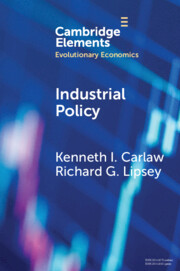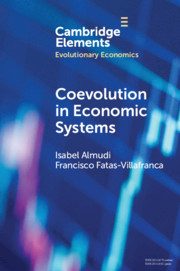Refine search
Actions for selected content:
51 results
Taxonomy and molecular phylogeny of Urocleidoides spp. (Monopisthocotyla: Dactylogyridae): Four new species and cophylogenetic patterns in a clade of species parasitizing Characiformes hosts
-
- Journal:
- Journal of Helminthology / Volume 99 / 2025
- Published online by Cambridge University Press:
- 29 August 2025, e97
-
- Article
- Export citation
9 - The U.S.-China Strategic Rivalry
- from Part III - East Asia since 1945
-
- Book:
- East Asian International Relations
- Published online:
- 28 November 2024
- Print publication:
- 19 December 2024, pp 248-279
-
- Chapter
- Export citation
A gene–culture co-evolutionary perspective on the puzzle of human twinship
-
- Journal:
- Evolutionary Human Sciences / Volume 6 / 2024
- Published online by Cambridge University Press:
- 11 November 2024, e47
-
- Article
-
- You have access
- Open access
- HTML
- Export citation
A macroscope of English print culture, 1530–1700, applied to the coevolution of ideas on religion, science, and institutions
-
- Journal:
- Social Science History / Volume 48 / Issue 3 / Fall 2024
- Published online by Cambridge University Press:
- 14 May 2024, pp. 489-519
- Print publication:
- Fall 2024
-
- Article
-
- You have access
- Open access
- HTML
- Export citation
4 - Coevolution of Firms with Sectoral, Regional, and National Systems
-
- Book:
- Innovation–Development Detours for Latecomers
- Published online:
- 15 February 2024
- Print publication:
- 22 February 2024, pp 106-144
-
- Chapter
-
- You have access
- Open access
- HTML
- Export citation
1 - Introduction
-
- Book:
- Innovation–Development Detours for Latecomers
- Published online:
- 15 February 2024
- Print publication:
- 22 February 2024, pp 1-24
-
- Chapter
-
- You have access
- Open access
- HTML
- Export citation
6 - Central Concepts
- from Part II - Protecting and Restoring Populations and Habitats: A Preservationist Approach to Conservation
-
- Book:
- Conservation in the Context of a Changing World
- Published online:
- 28 September 2023
- Print publication:
- 12 October 2023, pp 141-172
-
- Chapter
- Export citation
Chapter 9 - Conclusion
-
- Book:
- Clean Air at What Cost?
- Published online:
- 28 January 2023
- Print publication:
- 19 January 2023, pp 183-194
-
- Chapter
- Export citation
Chapter 3 - Darwin and Animal Studies
- from Part I - Environments after Darwin
-
-
- Book:
- After Darwin
- Published online:
- 01 December 2022
- Print publication:
- 15 December 2022, pp 33-44
-
- Chapter
- Export citation
Diversification processes between monogenoids (Dactylogyridae) and their marine catfish (Siluriformes: Ariidae) from the Atlantic coast of South America
-
- Journal:
- Parasitology / Volume 150 / Issue 2 / February 2023
- Published online by Cambridge University Press:
- 29 November 2022, pp. 184-194
-
- Article
-
- You have access
- Open access
- HTML
- Export citation
Evolutionary consequences of vector-borne transmission: how using vectors shapes host, vector and pathogen evolution
-
- Journal:
- Parasitology / Volume 149 / Issue 13 / November 2022
- Published online by Cambridge University Press:
- 06 October 2022, pp. 1667-1678
-
- Article
-
- You have access
- Open access
- HTML
- Export citation
12 - Sexual Conflict Theory
- from Part II - Middle-Level Theories
-
-
- Book:
- The Cambridge Handbook of Evolutionary Perspectives on Sexual Psychology
- Published online:
- 30 June 2022
- Print publication:
- 21 July 2022, pp 264-279
-
- Chapter
- Export citation
Fish–parasite interaction networks reveal latitudinal and taxonomic trends in the structure of host–parasite associations
-
- Journal:
- Parasitology / Volume 149 / Issue 14 / December 2022
- Published online by Cambridge University Press:
- 30 June 2022, pp. 1815-1821
-
- Article
-
- You have access
- Open access
- HTML
- Export citation

Industrial Policy
- The Coevolution of Public and Private Sources of Finance for Important Emerging and Evolving Technologies
-
- Published online:
- 21 June 2022
- Print publication:
- 14 July 2022
-
- Element
- Export citation

Coevolution in Economic Systems
-
- Published online:
- 12 May 2021
- Print publication:
- 10 June 2021
-
- Element
- Export citation
1 - Introduction
-
-
- Book:
- Culture, Mind, and Brain
- Published online:
- 18 September 2020
- Print publication:
- 24 September 2020, pp 1-50
-
- Chapter
- Export citation
3 - Human Evolutionary Behavior and Political Economy
- from Part I - Political Economy and Complex Systems
-
- Book:
- Network Origins of the Global Economy
- Published online:
- 17 March 2020
- Print publication:
- 19 March 2020, pp 57-76
-
- Chapter
- Export citation
3 - Speech and Social Evolution
- from Pleistocene Evolution
-
- Book:
- A History of Humanity
- Published online:
- 14 February 2020
- Print publication:
- 27 February 2020, pp 36-61
-
- Chapter
- Export citation
Multidimensional similarity in multiplex networks: friendships between same- and cross-gender bullies and same- and cross-gender victims
-
- Journal:
- Network Science / Volume 8 / Issue 1 / March 2020
- Published online by Cambridge University Press:
- 24 February 2020, pp. 79-96
-
- Article
-
- You have access
- Open access
- Export citation
